(This site is reader-supported. When you buy something using retail links on our articles, we may earn a small commission. As an Amazon Associate I earn from qualifying purchases.)
Nazi knives are the weapons that the Third Reich (the Nazi State) ruled by Adolf Hitler as the Chancellor used during their regime, especially during World War II. Thus, they are also known as the German Third Reich knives. Many were daggers; they are also known as the Nazi daggers or the German Third Reich daggers. The Third Reich is known to design some of the best edge weapons of all time.
At that time, the armed forces in the state possessed swords, knives, or daggers for almost every event. Considering the high quality, royal design, and oddity, these blades have become a center of attraction for many.
These tools’ top-quality construction, historical relevance, and charm make them an obvious army collectible. These daggers were also popular souvenirs for several World War II veterans serving in the European cinema.
The German officers who used these tools were an icon of power and status. However, instead of using them as weapons, World War II German officers utilized them as uniform accessories.
Seizing your foe’s blade or sword or getting it in surrender is important in combat. This is perhaps why we can see several Third Reich Nazi daggers and Katanas of Japan with civilians who are not necessarily knife enthusiasts or military collectors.
Unfortunately, as with any product having a high value, it has sadly become common to find fake Nazi daggers. They started to appear during the ending months of the war. Initially, these replicas were built using the original parts plundered from stores seized by the allied troops.
Today, you can easily come across new reproductions.
Types of Nazi Daggers and Knives
Several courageous allied soldiers considered these Nazi daggers essential to take home. These war-tired hands gradually buried these souvenirs away from sight. As many of these brave warriors are alas passing away, their daggers are coming to light through their relatives.
The daggers were designed in different forms and were made available to the German army officers, navy, political parties, air force, and social groups of the government. Each of them has a discrete design. No other nation’s army on the planet has ever recorded these many variations for daggers as the Third Reich’s armed forces.
Due to the variety of designs and diverse theme variations, these knives form a fascinating collection for historians and knife enthusiasts alike. Rarer models get sold for huge sums of money when kept at auction. Let’s take a look at the popular Nazi daggers and knives.
The German Army Dagger / The Heer Dagger

The German armed forces were keen on the appearance of their soldiers, as they wanted each of them to feel like a proud member. The German Army dagger is one of them.
The Army dagger was a normal dress accessory for the German Army (Heer) and not a weapon. They came with various design characteristics, such as a cross guard with the Nazi eagle with spread wings and swastika in its wreath and a pommel with an ornamental ring of oak leaves from the grip to the pommel’s top.
Unlike the famous SS and SA daggers, the blade was plain without the engraved motto. The scabbard was initially made up of brass, later replaced by steel. The grip had an inscribed spiral groove in orange, white, or yellow. It was made using stylish materials such as amber glass or ivory.
Originally released in 1932, the Army dagger is one of the most affordable German daggers. It had a single design, but one could customize it by engraving the blade and changing the handle color and hanger type.
The initial dagger featured a hard-to-find white handle, which later turned orange. It was worn by all field Marshall officers. It was last produced in 1944, after which no officers were allowed to wear it. Interestingly, no distinct marks were there on the dagger to distinguish between the low- and high-rank officers.
The charm of this dagger is in its plain yet eye-catching design. The handle features a celluloid swirl pattern in white or orange color, and a crown-shaped pommel made up of metal and oak leaves projecting from the sides.
The metal handguard has circular swirl ends. The army’s icon, the eagle with lengthy wings, is seen at the handguard’s front with its rear been left plain. The eagle’s beak features a straight edge just like an ax’s head. This design is called the hatchet face.
The blade has the manufacturer’s logo and reflects a knight’s helmet oriented towards the left. The ‘WKC’ initials with Solingen as the word below them are seen beneath the head. Did you know that WKC was known for its quality daggers? The blade has no Nazi motto in Gothic script.
The scabbard shows noticeable pebbling. Two braces, one at the midpoint and close to the throat, exist where suspension rings are affixed. The hangers are attached to these rings.
The arms of the cloth hangers are attached to only one metal bracket. They are seamed together so that they remain intact. When wearing, the bracket hooked onto a snap inside the officer’s jacket and hung at the side. At times, the appearance of this dagger was accentuated by covering the handle with a portapee. The whole body reflects a rust-like look.
The Luftwaffe Dagger / Air Force Dagger
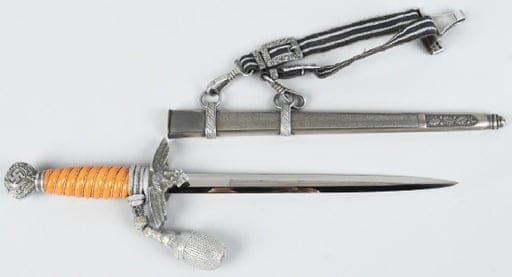
The Luftwaffe dagger was also a normal accessory for army officers and a few high-ranking non-commissioned officers of the privileged German Air Force (Luftwaffe). The knife has many features as that of the Army dagger.
A few of them are the Nazi eagle with a swastika, ornate pommel but with a protruding swastika at the center, oak leaves, blade without the motto, grips in three colors, and carved groove but highlighted using silver, brass, or aluminum wire.
There are two Luftwaffe knives, namely, the first and second models. The first type had nickel fittings, while the second one had aluminum. Even the pommel and handguard differed.
- First Model: The first model was introduced in 1934. Its distinguishing feature is the hanger affixed permanently to the scabbard. A clip at its end contains the brand name and is used to attach the knife to a carrying belt. The double-edge, not-sharpened blade is of stiletto type and has a flat plain center. The dark blue grip is made of celluloid and has a grooved spiral pattern. The groove may have a three-strand wire of aluminum and silver. The silver handguard shows a loose three-tear pattern. A swirl-type swastika is at its center. The blade’s base contains a small leather piece to offer padding. The dark blue scabbard is made using Corinthian leather to compliment the handle. There are three fittings on silver: at the throat, a chain strap, and a tip cover. The strap and throat fittings have a hanger chain permanently attached to them. The end of the chain shows a clip for keeping the dagger inside the uniform.
- Second Model: The Luftwaffe introduced the second model in 1934. All the metal fittings are made using cast aluminum. The rear of the metal handguard shows heavy pebbling, which varies from one manufacturer to another. The pommel is spherical and shows a swastika. Originally, it was gold in color. However, this color gradually vanished from most models. The scabbard’s sides are smooth and feature an oakleaf design at its tip and a pebbled finish throughout its body. The top of the scabbard has dark and light sections, of which the latter has an area where the eagle averted the color change. The scabbard features two metal braces with two rings. This is where the hanger of heavy-duty cloth and intricate patterns attaches to the knife. The scabbard also has metal fittings with square buckles in leaf shape, which allow adjusting the length of the hanger’s each side. The blade shows the manufacturer’s logo at its base.

The Kriegsmarine was the German navy’s identity between 1935 and 1945. It was the last armed service to use daggers featuring a swastika. The naval dagger usually had a metallic pommel, a handle with a white wire-wrapped pattern, an extended cross guard on both sides, and a scabbard with two suspension rings and two bands. There were two models of this navy dagger, which are as follows:
- First Model: This dagger was used during WWI and until 1938. The design had a pommel having a flame ball shape with a point above it and a wavy pattern below it. The cellulite handle had a swirled design featuring a wire wrapping pattern. The crossguard featured an anchor and a rectangular midpoint with extensions featuring a crown shape on both sides—a spring-loaded button in the front of the crossguard aided in locking the dagger to the scabbard. The scabbard featured several dimples and a hammered style. It had two bands, one near the middle and another close to the throat. A suspension ring existed from each band. A few daggers used a portapee that formed a silver cord, a loop culminating in a tight knot around the pommel and the crossguard. The blade was of a stiletto style, and almost half of it was embellished with etchings of anchors and leaves. The first model also showed a manufacturer’s logo at the locking mechanism, featuring a squirrel holding a sword.
- Second Model: This dagger had a design similar to the first model, with the crossguard and pommel as exceptions. The crossguard replaced the rectangular center with a square one. The pommel design adopted in 1938 had no flame ball shape but reflected an eagle with withdrawn wings showing some plumage, and its head was oriented to the left. The chest showed a feathering pattern. Typically, the eagle grabbed a wreath with a swastika in the middle. The scabbard was adorned with linear patterns in four sections. This embellishment was found in both rear and at the front. It had the same bands and suspension rings as in the first model. Its finial was usually flattened. All dagger parts were composed of brass, except for the blade. This helped the dagger to withstand the harshness of the open sea. The stiletto-style blade featured a double edge and the manufacturer’s logo on one side.
The navy personnel used a short-style dagger during the Third Reich. While the pommel and crossguard remained the same as in the second model, the stiletto-style double-edged blade was made using Damascus steel. The blade featured stunning detailing, which was packed to form an impossible pattern. The term ‘Solingen’ was etched at its base, which indicates the town name wherein the blade was made. Besides this, no other marks existed. Even the scabbard was a bit unique because it was made using leather, not metal. A strap prolonged along the handle’s length and had a belt at the top to fit the dagger well when within the scabbard.
Hitler Youth Knives (HJ Knives)
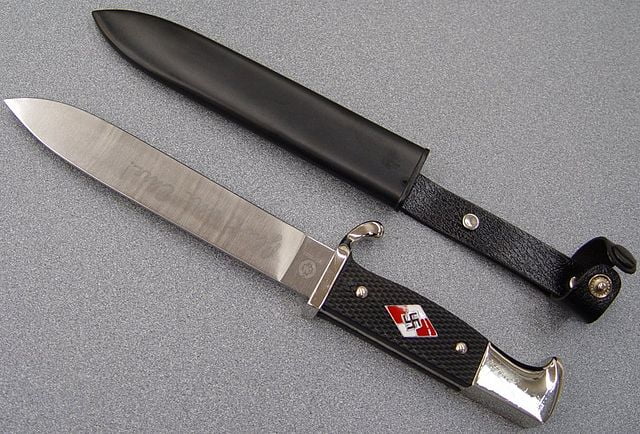
As the name suggests, Hitler Youth knives were made for the Hitler Youth (Hitler Jugend (HJ)). Hitler Youth was the Nazi form of the Boy Scouts with girls. The Nazi party’s paramilitary youth organization lasted from 1922 to 1945.
These tools were given as rewards to boys after clearing the state exams. These tools were sold to and carried by boys as a part of their uniform and were comparable to those borne by the Sturmabteilung or SA.
The early versions had the engraved motto, ‘Blut und Ehre!’, which means ‘Blood and Honor!’ Unfortunately, it is tough to find them in pristine condition as they were given to youngsters.
These knives were utilitarian, which means they were designed to be used in the field. The pommel is a solid metal area with a short expansion to a side. The handle with a checkered pattern is made of plastic and has two rivets to hold it firmly.
The diamond logo is at the handle’s center is made using enamel. There is a black swastika in the middle. The crossguard has one flat side, and the other extends upwards in a curvy way.
The metal scabbard is typically black. A spherical but small rivet is there close to the throat. Inside, two white pads, which may be missing from the scabbard, guide the blade while inserting the knife. These knives had different markings at the blade’s base, such as the district where it is issued, manufacturing cities such as Solingen, and RZM marking.
The plain blade has a single edge and has the motto. However, this motto is not found in the later models, perhaps due to excessive sharpening. The blade’s base has a leather washer. Initially, the blade’s hilt was not clearly defined, but the later models reflected a ridge to show the hilt.
A genuine HJ knife will have a rivet on the scabbard, not appear big, and have a diamond logo with a rocker motion. The latter is optional.
The SA Dagger
Produced in the millions by hundreds of makers from 1933 until the end of the war, the SA dagger is among the most affordable blades to pick. Interestingly, not all manufacturers made the full dagger; a few just collected parts from other factories, assembled, and put the logo on the plain blade. All SA blades are imprinted with ‘Alles Fur Deutschland,’ meaning ‘All for the fatherland.’
The SA daggers were ordered by Hitler for the adherents of National Sozialistische Deutsche Arbeiter Partei (NSDAP) or National Socialist German Workers Party. They acted as symbols of status and rank. The design had the elements of the Holbein dagger, a hunting knife in Germany of the 16th century.
The daggers had the Nazi eagle with prolonged wings wide, catching a wreath with a prominent swastika. In addition, there was a SA symbol in a sphere atop the wooden grip and a unique curved grip molded from maple, birch, and walnut.
The earlier models differed in sizes of handles, blades, and scabbards. Until the RZM numbering standard was introduced for universal quality control in 1934, it was tough or impossible to swap parts between SA daggers due to these differences.
A few early versions had no circular SA insignia but had a different phrase, ‘Deutschland Uber Alles’, meaning Germany Above All. Following are some of the SA daggers used during the Nazi regime:
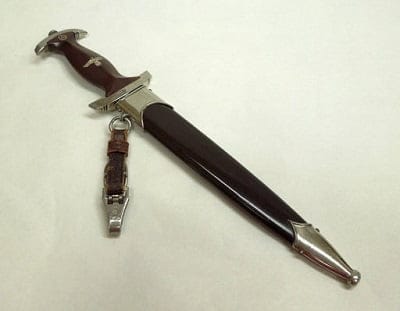
Standard 1933: Was a basic dagger produced copiously and issued to all SA members. It typically had a single leather hanger.
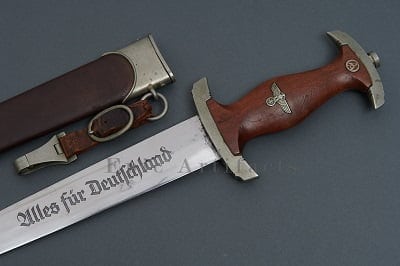
SA Rohm: Was made to acknowledge Ernst Rohm’s contributions to the SA. It was identical to the standard model, except that it came with an engraving, ‘In Herzlicher Freundschaft Ernst Rohm,’ meaning ‘In heartfelt comradeship, Ernst Rohm’, on the blade’s reverse area. However, later, all Rohm daggers were destroyed or were marked with a special inscription. Although hard to find, a Rohm dagger featured no RZM number but nickel-silver fittings instead of plated.

Marine: Was made for the members of the SA’s naval department. Two marine models existed, which were modeled based on the 1933 model. The first model had a black anodized scabbard and a black wooden handle with an eagle illustration and SA logo. The second model had a brown scabbard, brass or copper fittings, and a brown handle.
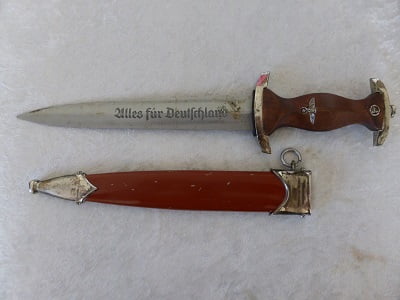
SA Honor: Was issued by Ernst Rohm and Victor Lutze, his successor. Those knives issued by Victor were given to high-ranking officers. It was often known as ‘brownshirts’ for the uniform’s color, which set it apart from Schutzstaffel (SS). Multiple configurations of this dagger existed but were as per the 1933 model. Some alterations included a crossguard and an adorned hilt. In addition, these models were embellished with oakleaf sculptures. Scabbard fittings were plain or adorned. The metal scabbard also had a brown leather wrap. The hanger had a brown leather strap. The early models had Damascus blades.
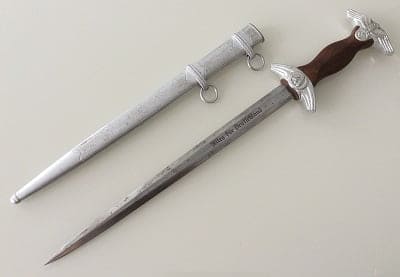
Feldherrnhalle: Feldherrnhalle marked the site where Hitler first tried to take control of Germany. In 1937, a new dagger of the same name and distinct design was made and issued for the Feldherrnhalle and Lutze’s staff leaders. The blade was identical to the Army blade, with the middle portion flat. Its other side had the maker’s logo (Eickhorn squirrel).
The SS Dagger
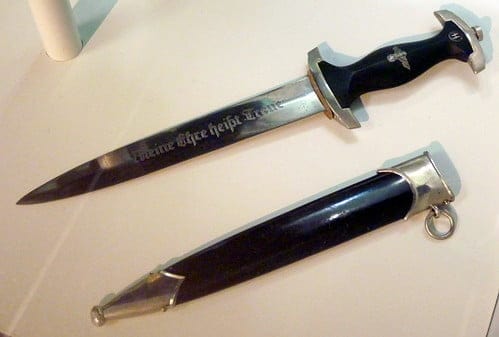
Made for elite members of the SS who were Hitler’s bodyguards, the SS daggers are identified by the deep black handle and a round ‘SS’ button atop the grip beneath the top cross guard. The design has many instances of Nazi symbolism.
More noticeable design features include the Nazi eagle with a wreath and swastika, the ebony wood grip in black, and the blade’s center with the motto ‘Meine Ehre Heist Treue,’ meaning My Honor is Loyalty.
SS daggers had RZM numbers, although many had no markings on the blade. The pommel had a small round nut. Zinc fittings existed at the handle’s both ends. The scabbard was of metal and in black. The throat had a suspension ring where the hanger was attached.
Some SS dagger models were 1933, SS Rohm honor, and 1936 SS honor. However, due to high popularity, many fake models of the SS dagger were produced later.
The German Red Cross Dagger
Known as Deutsches Rotes Kreuz (DRK), the German Red Cross existed before the Third Reich and functioned as a civilian organization crewed by volunteers and a few paid personnel. It was recognized as per the Geneva agreement of 1929.
As per the Geneva rules, the Red Cross members involved in fighting should not wear a weapon when performing their civilized duties.
The DRK initially used the swastika as its symbol and later started using a dagger. The members wore the subordinate hewer or the leader’s dagger as per their rank.

Red Cross Subordinate Hewer: It had a dual purpose of being worn at special programs such as parades and weddings and carried to the frontline. It featured a large, heavy, and menacing blade of chromed finish and a double-tooth serrated rear covering most of the blade length. The serrated edge was used on the battlefield. The tip ends shortly in a straight cut to adhere to the requirements of the Geneva rules that did not allow a pointed tip. The pommel was a solid metal of silver color, while the handle was of plastic. The handle’s front part showed a checkered pattern, whereas the rear was smooth. Even the thick cross guard was silver in color. In its middle was an eagle within an oval. The scabbard was metallic and had smooth black paint. The round finial was of silver metal. An anchor of a leather frog appeared close to the throat’s neck. A belt loop existed in its upper area.
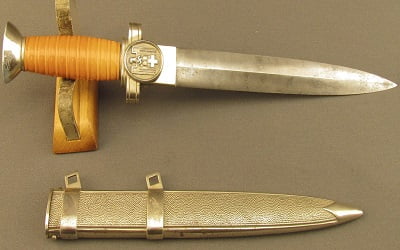
Red Cross Leader Dagger: Only those of leader rank used this dagger, which was meant to be worn only with the uniform as per the Geneva conventions. Its design had an oval pommel of silver metal with a multi-point head screw to hold all the other dagger parts in place. The orange handle was made using cellulite plastic and had a swirled design. The scabbard was made using a metal piece and had pebbling panels. The finial was integrated instead of being available as a separate fitting. The stiletto-style blade had a sharp point and a double-edged style. The crossguard with the oval eagle was noticeable enough to cover a part of the blade’s base. It was made using a single piece with many liens, making it look like a multi-piece construction. The pebbling pattern covered the rear and front panels of the scabbard. Fabricated bands existed at the scabbard’s throat and mid-point, where a hanger was linked using clips. The hanger suspension opening was rectangular.
The RAD Dagger
The Reichsarbeitsdienst (RAD) or the Reich Labor Corps organization was established to uplift the condition of the economic downturn by employing people to rebuild the national infrastructure and developing public work programs.
Service was perceived as a bridge between school finishing and military service. As a result, RAD issued two different daggers, subordinate hewer and leader dagger, which had the Eickhorn logo stamp on the blades until 1941.

RAD Subordinate Hewer: It featured a stag horn handle, an upturned cross guard, and a pommel with an eagle head. The metallic scabbard had two big fittings plated with nickel, one being the finial with the RAD logo featuring a spade with two wheat sheaths and the other with a Celtic design in the throat area. Three different handle models were used for this hewer. The single-edged, chromed blade was stout, with the spine tapering close to the end to give a distinct tip look. A blood groove covered more than half of the blade. A motto called ‘Arbeit Adelt,’ meaning ‘Labor enables,’ existed in the middle of the blade. The enlisted members and leaders wore this dagger for the initial three years of its introduction.
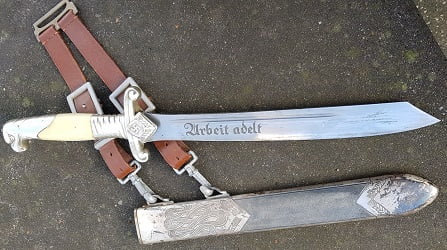
RAD Leader Dagger: It was lighter and was more embellished than the hewer. All scabbard fittings were plated with nickel or silver. The handle was either yellow or white. The pommel showed the eagle head, while the cross guard showed the RAD logo in the middle. It had a double-turn-down design. The single-edged blade had the same design as that of the hewer.
NSKK Dagger
The Nationalsozialistisches Kraftfahrkorps (NSKK), or The National Socialist Motor Corps, was the Nazi’s small paramilitary organization operated from 1931 to 1945. Its members used the following daggers:
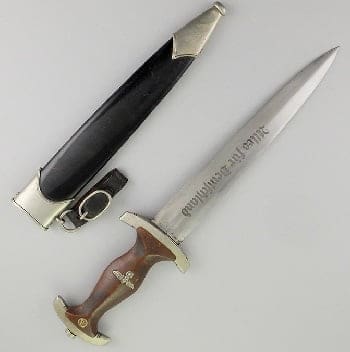
1933 Pattern NSKK: The frontline personnel used this dagger from 1933 to 1945. The blade had the stiletto style and a double edge. One of its sides had the motto, ‘Alles fur Deutschland,’ meaning ‘All for the Fatherland.’ The knife also featured a small, cylindrical pommel and lower and upper cross guards made using copper or tombak. The handle was of wood and had the shape of a Coke bottle. On its side, a SA eagle was added along with a SA circular device above it. The daggers came with a triangular paper bag, and a triangular, black-lined tag draped around the handle. A metal rivet kept the sides closed, while the center had the NSKK eagle and the text, ‘NSKK – Dienstdolch’. The paper bag was light brown and said, ‘NSKK Dolch.’ A few bags also showed the RZM number.

Marine NSKK: This dagger was a lightly modified version of the standard NSKK dagger and belonged to the marine section of the NSKK. There were two models of scabbards for this dagger, namely, basic and chained. Both had fittings with copper or tombak finish. The dagger’s chained version was the model 1936, featuring a unique middle segment. The chain was affixed to the middle and top fittings.
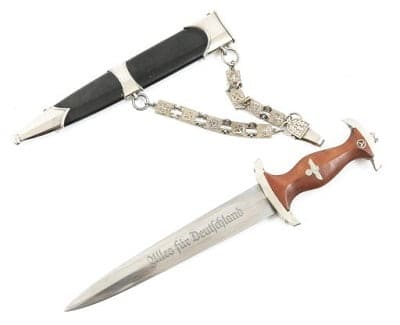
Model 1936 NSKK: This dagger was a response to the chained SS dagger. It was similar to the 1933 NSKK pattern, with the only exceptions being the inclusion of a suspension chain and the addition of a mid-point prop on the scabbard to hold the chain’s lower section. The chain had square segments affixed using locker rings to each other. Each portion of the chain was embellished with an eagle and a sun wheel swastika. Both portions of the chain were affixed using suspension rings to the scabbard. Two types of fittings were used: nickel silver in the early versions and nickel plating over the base metal in the newer ones.
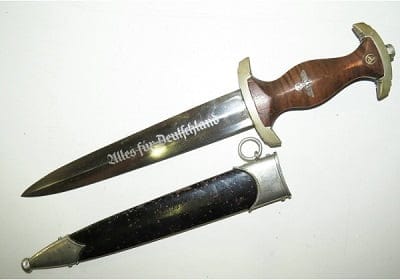
NSKK Rohm: This NSKK dagger was derived from the SA. Its blade was identical to that of the normal NSKK dagger. While one side mentioned ‘Alles fur Deutschland’, the other specified the motto, ‘In Herzlicher Freundschaft Ernst Rohm’ meaning ‘In heartfelt comradeship, Ernst Rohm’. You can find this dagger in three states, in Rohm inscription (toughest to find), with the Rohm name removed and the manufacturer’s logo removed.
The RLB Dagger
The RLB was the National Air Defense League, a paramilitary organization that was issued daggers to be worn with the uniform. Two types of daggers were initially adopted in 1936: the subordinate and the leader. In 1938, modified versions of these daggers were introduced and were termed, Second models.

First Pattern 1936 Subordinate: This dagger came with a spherical silver pommel, wooden or ebony handle, cross guard with extended wings and a squarish eagle oriented to the right, and a metallic scabbard. The handle showed the RLB logo on one of its sides. The eagle’s feet showed a wreath with a swastika in the center. The double-edged blade was of a stiletto style with a middle ridge spanning the entire length and had no motto. Due to the blade’s short length, the dagger was a knife. The black scabbard had a tip with a silver fitting, a rivet close to the throat, a leather strap, a triangular suspension bracket, and a spring-loaded silver clip.

First Pattern 1936 Leader: This dagger had a design similar to the subordinate one, except for the overall length, which was more by an inch. The pommel had an oval shape, and a bit raised middle portion. The handle was constructed using wood and dark blue or black leather coating. Its middle part had the RLB starburst logo. The crossguard showed an art deco eagle with extended wings to form guards. The metallic scabbard had two silver-plated fittings; one was the finial and the other at the throat. One of its sides had a suspension ring where a leather strap acted as a hanger.

Second Pattern 1938 Subordinate: This dagger had a design similar to the former subordinate model except for the metal logo at the handle’s center. The round pommel was of metal and silver in color. The lower area spanned beyond the perimeter to generate a thick ring. The metal logo was now large RLB initials and a small swastika at the base. The blade’s center ridge spanned across its entire length.

Second Pattern 1938 Leader: This dagger had a design similar to the former leader model but with few differences. The original big RLB letters followed by a small swastika was now only a big black enamel swastika. The scabbard had one more fitting in its middle part and the two fittings. Suspension rings were present in the middle and upper fittings.
The K98 Bayonet
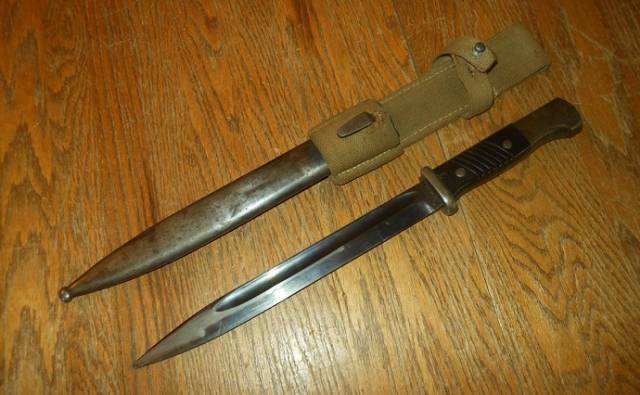
The K98 bayonet was made to be mounted on the 98K Mauser rifle. It featured a metal pommel with a rectangular press button on one end and round on the other. It was a spring-loaded device that aimed at separating the bayonet from the rifle. The pommel had stampings such as eagle shapes.
The handle grips were either of wood or bakelite. The scabbard was metal and had leather or khaki frog stud close to its throat area. The finial component reflected a ball shape. Additional markings such as the maker’s identity, serial number, and year were seen in the throat area.
The single-edged blade was made using blue tempered steel. However, at the tip, there was a double-edged design. A thick blood groove spanned to cover more than half the length of the blade.
The German Fighting Knife
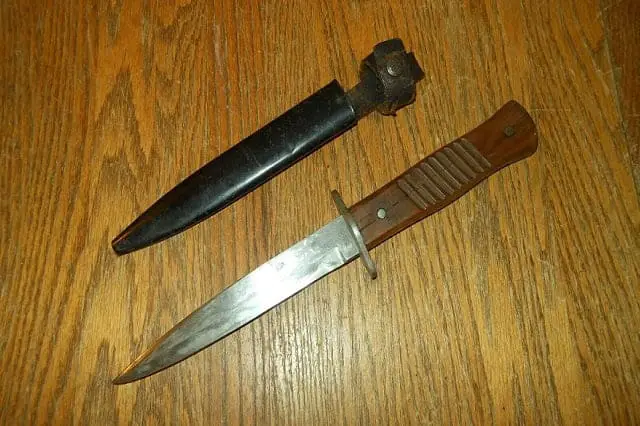
The fighting boot knife, introduced during WWI for combats in trenches, was used throughout WWII. It was small in size to carry it on the boot side. It came with different blade shapes, such as single-edged, double-edged, and a mix of the two with a larger ricasso.
The pommel had a small wooden projection, while the cross guard was simply a thin piece of metal with only one side inclined to a few degrees. In some models, the crossguard was a thicker piece of metal whose width was not bigger than the rest of the knife.
The handles were constructed using different designs and materials. However, a common characteristic was that two or three rivets fastened them. Some handles were utilitarian without any attractive finish. The costly ones were more refined and had brighter colors and smooth textures.
The scabbard was black, but the pint was worn off to show the metal finish. It had a large clip for carrying the knife on the belt or via a boot.
The Dress Bayonet

A few non-military groups only used dress daggers, which marked their status symbol. As these bayonets were not for combat use, not all had a guide, an opening in the pommel, and handle portions that helped secure the bayonet to the rifle. Color felt inserts were added to the guide.
Different handles were seen on these daggers, such as stag handles, a black plastic handle with a crisscross pattern, and a stag handle with a silver police icon in the middle. Two rivets secured the handle grips. Their shape and size differed significantly as per the model. Some were simple, while others had embellishments like a dome head.
Most pommels had the shape of a bird’s head in which the eye was a press button. Most blades were chromed and were plain. However, many owners had engraved it with military scenes, mottos, and eagles.
Conclusion
Nazi knives are worth having in your unique collection, whether a seasoned or a beginning collector. Unfortunately, while many fake models come across, the original or genuine ones have ceased to exist. Thus, you are likely to have a hard time finding the original daggers of the Nazi regime.

Hi, I am Jay. I am the creator of Knife Guides, your one-stop site for everything related to knives. I am a computer engineer by profession, knife aficionado by passion. Here I work with a group of people who’ve always had a passion for knives and blades. Over the years we’ve kind of become experts and decided to share our knowledge and ideas. I am also an avid hiker and enjoy offshore gamefishing.

